
Paspalum is a genus of plants in the grass family.
Pachystroma is a monotypic plant genus in the family Euphorbiaceae first described as a genus in 1865. It is the only genus of its tribe (Pachystromateae). The only known species is Pachystroma longifolium, native to Brazil, Bolivia and Peru.

Claoxylon is a flowering plant genus in the spurge family, Euphorbiaceae, comprising dioecious subshrubs to small trees. It was first described as a genus in 1824. The genus is distributed in paleotropical areas: Madagascar through South and Southeast Asia, Malesia to Melanesia, Hawaiʻi, and Australia. Half of the species are in Malesia.
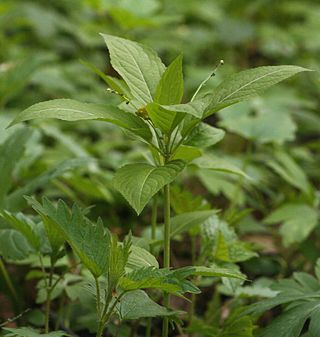
Mercurialis is a genus of plants in the family Euphorbiaceae, the spurges, known commonly as the mercuries. These are slender herbs (forbs), rhizomatious perennials and woody perennials, native to Europe, North Africa, and Asia.
- Mercurialis annuaL. – most of Europe, North Africa, the Middle East, and islands of the eastern Atlantic
- Mercurialis canariensisObbard & S.A.Harris – Canary Islands
- Mercurialis corsicaCoss. & Kralik – Corsica, Sardinia
- Mercurialis ellipticaLam. – Spain, Portugal, Morocco
- Mercurialis huetiiHanry – Spain, France, Morocco
- Mercurialis leiocarpaSiebold & Zucc. – China, Japan, Korea, Ryukyu Islands, Thailand, Assam, Bhutan, Nepal
- Mercurialis × longifoliaLam. – Spain, Portugal, France (M. annua × M. tomentosa)
- Mercurialis ovataSternb. & Hoppe – C + E Europe and SW Asia from Germany + Italy to Russia + Syria
- Mercurialis × paxiiGraebn. – C + E Europe from Germany to Crimea (M. ovata × M. perennis)
- Mercurialis perennisL. – most of Europe plus Algeria, Caucasus, Turkey, Iran
- Mercurialis reverchoniiRouy – Spain, Morocco
- Mercurialis tomentosaL. – Spain, Portugal, France, Balearic Islands

Koilodepas is a genus of plant of the family Euphorbiaceae first described as a genus in 1856. It is native to Southeast Asia, India, Hainan, and New Guinea.
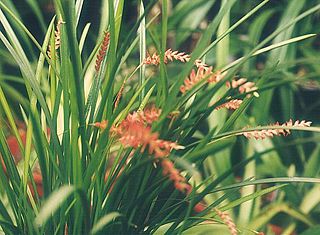
Dendrochilum was a genus of epiphytic, lithophytic and a few terrestrial flowering plants in the orchid family (Orchidaceae). It is now considered to be a synonym of Coelogyne Lindl. The name of this genus was derived from Ancient Greek words dendron ("tree"), and either cheilos ("lip") or chilos, alluding to either the flowers' large lip or to their epiphytic growth. These orchids are popular among fans of non-traditional orchid curiosities.

Monoon longifolium, the false ashoka, also commonly known by its synonym Polyalthia longifolia, is an Asian small tree species in the family Annonaceae. It is native to southern India and Sri Lanka, but has been widely introduced elsewhere in tropical Asia. This evergreen tree is known to grow over 20 m. in height and is commonly planted due to its effectiveness in alleviating noise pollution. It exhibits symmetrical pyramidal growth with willowy weeping pendulous branches and long narrow lanceolate leaves with undulate margins.

Conioselinum is a genus of flowering plant in the family Apiaceae, native to Eurasia and North America. Its species are erect perennial plants with deeply toothed compound leaves and umbels of white flowers. Plants of this genus are known commonly as hemlock-parsley.
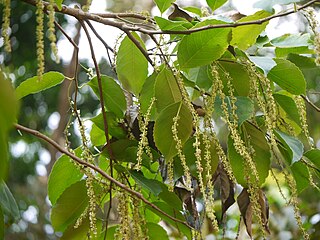
Homalium is a genus of plants in the family Salicaceae.

Uvaria is a genus of flowering plants in the family Annonaceae. The generic name uvaria is derived from the Latin uva meaning grape, likely because the edible fruit of some species in the genus resemble grapes.

Eriogonum longifolium, the longleaf eriogonum or long-leaf wild buckwheat, is a dicot of the family Polygonaceae. In addition to populations of E. longifolium var. longifolium found in Arkansas, Kansas, Louisiana, Missouri, New Mexico, Oklahoma, and Texas, there are varieties or subspecies that are geographically isolated and at various levels of endangerment. According to the University of Michigan Native American Ethnobotony database, Eriogonum longifolium has been used as a food by the Kiowa and as a medicinal by the Comanche.

Catasetum longifolium is a species of orchid found from northern South America to northern Brazil.
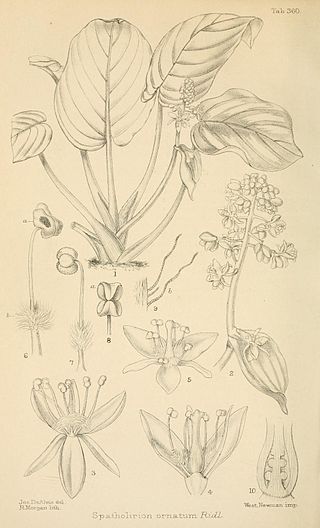
Spatholirion is a genus of climbing or rosette monocotyledonous flowering plants in the dayflower family. It is distributed from China in the north, south to Thailand, Vietnam, and northern Peninsular Malaysia. It has four to eight seeds per carpel, unlike the closely related Streptolirion, which has only two, and white or purple petals. The inflorescence axis of Spatholirion longifolium and all of its branches are a bright purple, probably aiding in visual pollinator attraction. The genus was first described in 1896 by Henry Nicholas Ridley, the father of the commercial rubber industry, from plants sent to Kew Gardens from the Malay Peninsula near the border between Thailand and Malaysia. All species have a diploid chromosome number of 20.

Jean Marie Bosser, sometimes listed as Jean-Michel Bosser was a French botanist and agricultural engineer who worked extensively in Madagascar and Mauritius.

Dracophyllum longifolium, commonly called inaka, is an upright shrub or small tree in the family Ericaceae that is endemic to New Zealand.
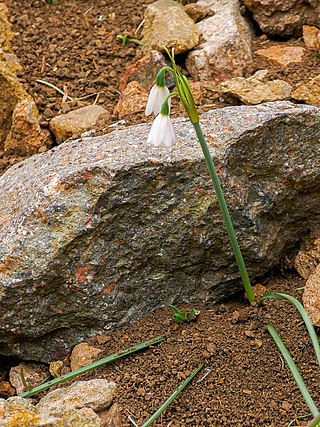
Acis longifolia is a species of flowering plant in the family Amaryllidaceae, endemic to Corsica. Its white flowers appear in spring. It is sometimes cultivated as an ornamental plant, but is not fully frost-hardy.
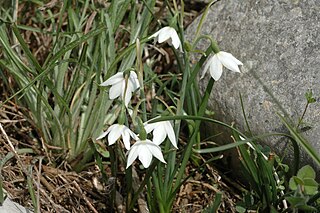
Acis nicaeensis, commonly called the winter snowflake, Mentone snowflake and French snowflake, is a species of flowering plant in the family Amaryllidaceae, native to south-eastern France. A small spring flowering bulb with white flowers, it is cultivated as an ornamental plant.

Filicium is a genus of flowering plants in the soapberry family Sapindaceae, native to east Africa, Madagascar, India and Sri Lanka. The best known species is Filicium decipiens, which is planted as an ornamental tree.

Claoxylon hillii is a plant in the family Euphorbiaceae found in New Guinea and northern Australia. It is a small tree to 15 m (49 ft) tall, first described by English botanist George Bentham in 1873.

Claoxylon angustifolium, commonly known as narrow leaf claoxylon, is a plant in the family Euphorbiaceae found only in Queensland, Australia. It is a shrub which will usually grow to a height of about 4 m (13 ft), with long narrow leaves up to 22 cm (8.7 in) by 2 cm (0.79 in). The flowers are small, about 2 mm (0.08 in) diameter, and the fruit are capsules, green when ripe, and about 6 mm (0.24 in) long by 8 mm (0.31 in) wide. It was described in 1865 by Swiss botanist Johannes Müller Argoviensis. Its natural range is from the Mount Windsor National Park west of Mossman Gorge, south to Eungella National Park west of Mackay


















